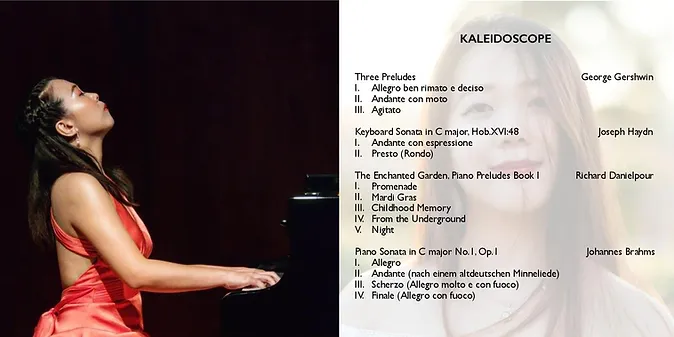KALEIDOSCOPE Piano Solo Album
I gave this album the title, “Kaleidoscope”, because of the diverse repertoire it includes. The album, which displays a variety of colors and imagination from the piano, takes you into a vibrant world where the piano is not just a single instrument; it is an ensemble. Each piece in this album has its own distinctive personality, offering an array of musical characters, tone colors, sound effects, and tales.
The album begins with George Gershwin, an American composer of the early 20th Century who traversed the worlds of both modern and classical. In his work, Three Preludes, he invoked his peculiar idiosyncrasy of blues and classical by fusing syncopated rhythms and underlying jazzy chords. Despite all their complexities, three candid vignettes come to fruition emanating sophisticated ease. Commencing this album with the Three Preludes establishes the statement that this collection of works will entail a broad range of styles and personas.
After such zest in the beginning, we move back to the 18th Century and enter the world of Joseph Haydn’s Sonata in C Major. It exudes both poignant elegance and intrinsic simplicity, evident in its theme being only two bars long. The decision in placing a work of Haydn’s after Gershwin’s suggests an assertion of both paradox and homogeny. In spite of being spawned from two completely different eras and cultures, both pieces radiate such simplicity upon fantastical pianistic complexities. My intention in positioning these works together indicate the vividness in color and character a piano can demonstrate through just syntactical decisions.
The fantastical attitude is prevalent in this collection and from Haydn, we travel to the tail end of 20th Century America: Richard Danielpour’s The Enchanted Garden Piano Preludes (Book I). As specified in his notes, these Preludes were inspired by his dream life. It is somewhat an illustration of the polarity between his subconscious and conscious reality, hence Danielpour calling this work a ‘garden of the mind’. The piano becomes the narrator of Danielpour’s concept. The audience is again acquainted with another particular musical language, and it only demonstrates the phenomenon of the piano.
In contrast to the role of the piano in Danielpour’s Preludes, the album concludes with a composer who has the ability to conjure up an orchestra out of one instrument. In his First Piano Sonata, Brahms creates a symphonic world of soundscapes, allowing the piano to become a vessel for his symphonic ideals. Brahms’ writing is a testament to the aptitude of the piano, in revealing how one instrument can produce such perplexities in expression and color. By juxtaposing Brahms and Danielpour in this collection, I want to unveil the comprehensive capacity of the piano and demonstrate its versatility as an instrument.
These specific preferences in repertoire are my striving to exhibit the beauty of the piano. I also want to convey to listeners the potency of a composer; their ability in expressing opens our ears and our imaginative world. On a personal note, these pieces are both an empowerment and an inspiration in my personal exploration of musical soundscapes.
For more information about the album and the recording tracks, please click HERE.


